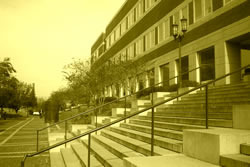April 2nd: Let's Explore the
Inner
Workings of HAL
Announcements
- University of Louisville in the Final Four!!!
vs. Wichita State... Sat., 4/6 @ 6:09 on CBS
- When's the championship game?
Plan of Attack
The Wonderful World of Machines
Disclaimer: I know some of you are thinking "What possible benefit can we get from reading and discussing old technologies like cordless phones and VCRs?" In fact, one student commented that these examples aren't useful because we [of a generation] find the devices to be intuitive. Although your intuitiveness is a benefit to your using contemporary machines, our goal is to understand the process users--lay and not-so-lay alike--go through when approaching machines and devices. Operating these devices might seem like "common sense," but don't forget that common sense is socially constructed. You may know how to use devices, but can you explain how from a users' perspective?
Also, VCRs are similar in complexity to program and switch as HDTVs are. In fact, HDTVs have quite a few modes and menus: component, TV, AV1, AV2, etc. Furthermore, I'm sure you can draw connections to DVRs.
Taming Hal Ch. 5, 6, and 7
Taming Hal: Designing Interfaces Beyond 2001 asks us to think about ways to understand machine behaviors.
Let's head over to our Taming HAL page.
"Rhetoric of Technology" preview
Although this isn't in the book, what term do we use for technologies having similar features across platforms, devices, or, well, technologies?
remediation
Guess what we call design cues that refer back to older devices that required the design to have the product work--hold up, run, or stay together? For instance, the new plastic showers have grooves for ornamentation: These grooves are derivative of past tile showers that had grout in between the tiles. Therefore, the grooves on newer showers are a skeuomorph
User Document #2
I didn't finish commenting on all your User Docs #2, so I can't turn them all back to you, but I have noticed some trends and want to address them, so you can avoid doing the same things on User Doc #3.
User Doc #2 Preliminary concerns:
- Make your document the appropriate length to explain the procedure
- Try not to have your docs look like assignments
- Cite your images!!!
- "Google Images" is not a source
- Provide the URLs at the very least
- Post-test answer choice (Strongly Agree, Agree, Neutral, etc.) should flow logically from the questions
- Is Times New Roman the only typeface choice?
- No full screen shots
{unless you're instructing someone on how to use their laptop or desktop for the first time--before they've added programs, wallpaper, etc.}
- Your Description is a good place to mention the scope of the tutorial/instructions/procedure
- The meta-analysis persona document IS important--make sure you include everything
- Is it unethical to go against user expectations?
Persona specific:
- Personas with no names: this is a a major red flag
- Personas with no pictures: another red flag
- Figure X: Image of [Persona's Name]
You should also cite where the images came from
- Personas focus on computer/technical literacy; they aren't scenarios about why the persona wants or needs your document
- You want to list attributes that allow us to make assumptions about techno-literacy
- Multiple technoliteracies (Kellner)...let's discuss if we have time
- Any thoughts on technocracy...
Persona Research
It might be a good idea to ask questions about your persona research tonight.
HAL Presentations for
5181 Students
Those of you enrolled in 5181 will be doing
a nice 4-5 minute presentation on HAL or inspired by HAL. I
originally wanted you to take an aspect of user design from the book and
discuss it. For instance, you could take one of the big case studies/examples
and present the issue to the class in your own words. One of the disasters or
mishaps would work well. Just get up in front of class and convey the
information to the non-expert audience.
Remember, presentations are not ALL
ENCOMPASSING descriptions; they're astutely concise representations of a
topic.
User Test for User Document #3
Now is the time for your final user test. Make sure you reviewed the guidelines on the assignments page. I would like all of you to have three users tests your documents because I'm giving you more time. Make sure you give the user the post-test questions. Don't have those...get moving on that! Also, turn in the results of your post-test questions (filled out with user names on them) next week (4/9) when you turn in your User Doc #3. If you don't have 3 copies, have them do electronic versions (word doc), and print them out for next week.
Before We Go...
Keep reading Degani's Taming Hal: Designing Interfaces beyond 2001 for next week. Next week's reading--Ch. 8, 9, and 10--is our last bit of reading. Consider Degani's argument that "'we' need more sophistication in our interfaces" (p. you need to find it).
Please have your User Document #3 next week. Also, don't forget to bring your books with you next week.
Additionally, those of you enrolled in 5181 have your Bibliographic Essays and your HAL presentations due in two weeks (4/16).
.. |
